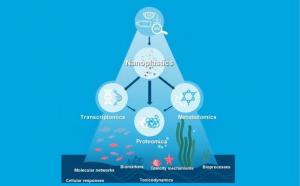GA, UNITED STATES, November 1, 2024 /EINPresswire.com/ -- A pivotal study has unveiled the deep-reaching molecular effects of nanoplastics on aquatic organisms, underscoring the pressing need to unravel their toxicity pathways. Using advanced multi-omics analysis, the research highlights how nanoplastics interact at the cellular level across various species, presenting a critical call to understand these interactions to safeguard ecosystem health.
Plastic pollution has become a growing crisis for aquatic environments, with nanoplastics emerging as particularly hazardous due to their minuscule size and broad dispersal. Unlike larger plastic fragments, nanoplastics infiltrate cellular systems and affect organisms in intricate ways. Given these risks, an in-depth understanding of nanoplastic toxicity is essential to formulating strategies for reducing their impact on marine and freshwater life. Addressing these challenges requires comprehensive research into the molecular effects of nanoplastics on aquatic species.
Published (DOI: 10.1007/s11783-024-1893-3) on August 10, 2024, in Frontiers of Environmental Science & Engineering, this review conducted by a research team from the University of Southern Denmark and Nanyang Technological University utilized transcriptomics, proteomics, and metabolomics to probe the molecular effects of nanoplastics on aquatic organisms. Researchers assessed molecular responses across species, revealing significant cellular disruptions and underscoring the vital role of multi-omics techniques in advancing our understanding of aquatic ecotoxicology.
Through a multi-omics approach, the study revealed that nanoplastics provoke various toxic responses in aquatic organisms, notably through oxidative stress, metabolic disturbances, and photosynthesis inhibition. By integrating data from transcriptomics, proteomics, and metabolomics, researchers mapped these impacts across biological layers, from impaired protein synthesis and cellular energy pathways to stress-related gene expressions. Importantly, the study found both common toxicity responses across species and distinct molecular reactions among fish, algae, and invertebrates. These findings underscore the value of multi-omics in detailing the complex ways nanoplastics impact aquatic ecosystems, highlighting the need for precise interventions to address this pervasive threat.
Lead author Dr. Mohamed Helal commented, "Our research sheds light on the complex molecular interactions of nanoplastics within various aquatic species. By integrating multi-omics data, we gain a more detailed view of the toxicity mechanisms, which is critical for evaluating the ecological risks posed by nanoplastic pollution."
The study's findings on nanoplastic toxicity carry crucial implications for environmental policy and pollution control. By clarifying nanoplastics’ molecular impacts, regulators can create targeted strategies to monitor and mitigate plastic contamination in aquatic ecosystems. Furthermore, this research emphasizes the ongoing need for advancements in omics technology to support more effective conservation measures.
DOI
10.1007/s11783-024-1893-3
Original Source URL
https://doi.org/10.1007/s11783-024-1893-3
Funding information
This study was funded by the Sapere Aude Research Leader program from the Danish Council for Independent Research (No. 0165-00056B). KET has been supported by the Research Council of Norway (No. 315969), “In silico and experimental screening platform for characterizing the environmental impact of industry development in the Arctic (EXPECT) and NIVA’s Computational Toxicology Program (NCTP; Research Council Project No. 342628).
Lucy Wang
BioDesign Research
email us here
Legal Disclaimer:
EIN Presswire provides this news content "as is" without warranty of any kind. We do not accept any responsibility or liability for the accuracy, content, images, videos, licenses, completeness, legality, or reliability of the information contained in this article. If you have any complaints or copyright issues related to this article, kindly contact the author above.


